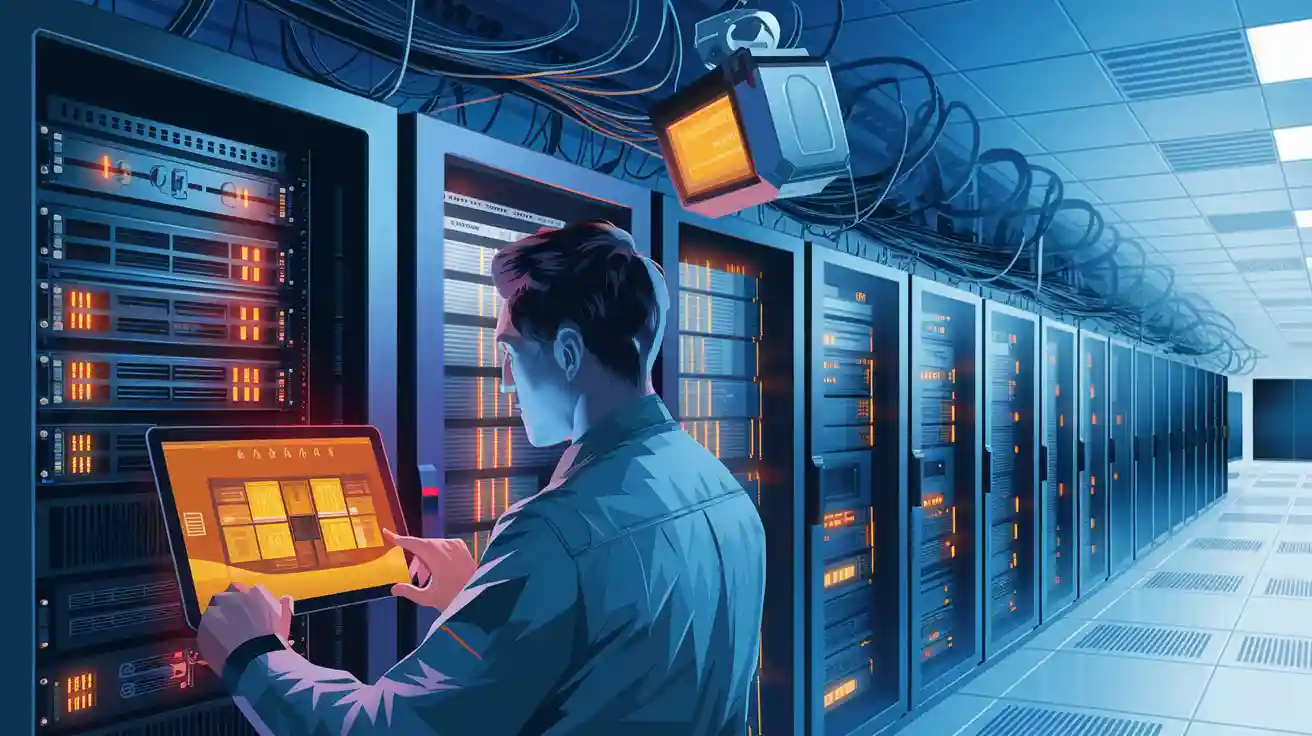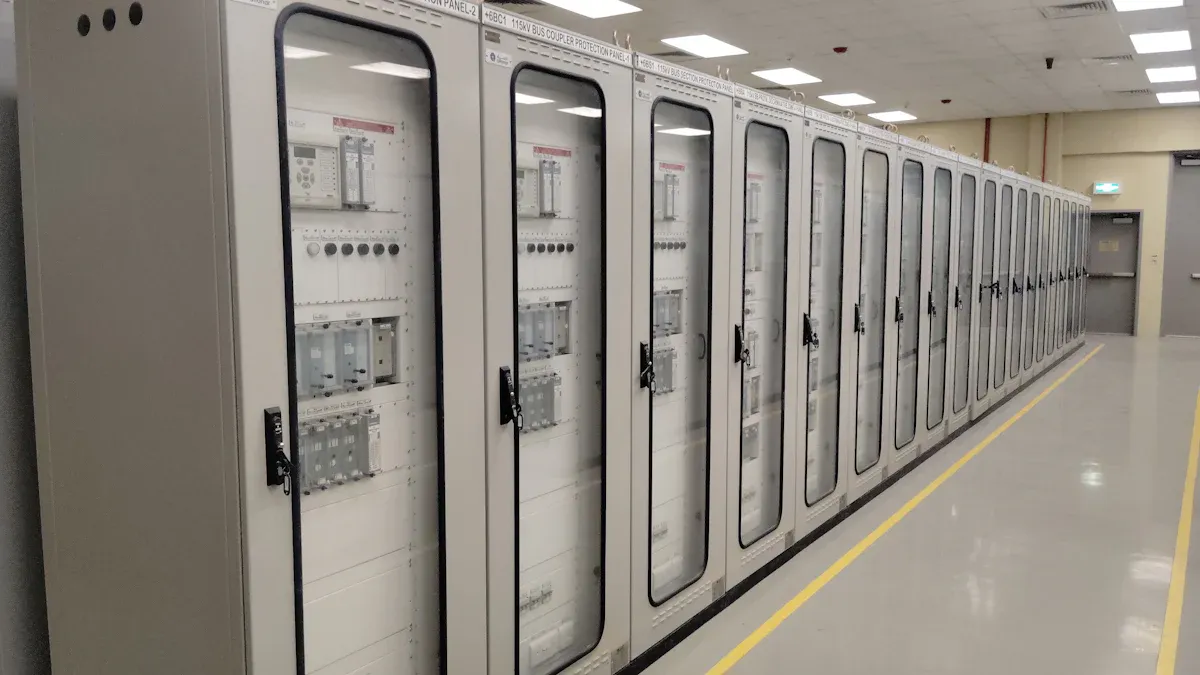
Imagine you walk into a data center. The servers make a quiet humming sound. They help run important things. You use a data center hot spot monitoring thermal camera to keep equipment safe. These cameras find heat problems very well. They help you see overheating before it gets dangerous. Early warnings keep you safe. They stop fires or broken equipment. With smart tools like the Turing A640 Uncooled Infrared Module (Imaging), you find problems fast. Good monitoring helps you stay safe and protect important things.
Key Takeaways
Thermal cameras find hot spots in data centers. They help you spot overheating problems early, before things break.
Checking with thermal cameras often stops shutdowns and lowers repair bills. This helps your business save money.
Early warnings from thermal cameras let you act fast. This keeps equipment and people safe from fire dangers.
Put thermal cameras in important places for better watching. This helps you find problems quickly and easily.
Use thermal cameras a lot to watch temperature changes over time. This helps you fix things early and keeps everyone safer.
Data Center Hot Spot Monitoring Thermal Camera

What Are Hot Spots?
Some places in your data center feel warmer. These warm spots are called hot spots. Hot spots happen when heat builds up. This usually happens near busy servers or equipment. You can find these spots with a data center hot spot monitoring thermal camera. The camera helps you see temperature changes in the room. Traditional temperature sensors only show numbers at one spot. Thermal cameras give you a full view of heat patterns.
Tip: Thermal cameras help you see temperature changes and heat spots. This makes it easy to find hot spots fast.
Hot spots can happen for many reasons:
Bad airflow or blocked air paths
Servers packed close together
Wrong use of floor tiles or blanking panels
Old cooling systems that cannot handle new work
Thermal cameras can find tiny temperature changes. They can see changes as small as 1/20th of a degree. Regular sensors do not show this much detail. Using a data center hot spot monitoring thermal camera gives you a clear look at where heat gathers and moves.
Why Hot Spots Threaten Safety
Hot spots can cause big problems in your data center. If you ignore them, equipment can get too hot and break. This can cause downtime and loss of important data. A data center hot spot monitoring thermal camera helps you spot these dangers early.
Here is a table that shows the main risks from missed hot spots:
Risk Type | Description |
|---|---|
Equipment Failure | Too much heat can hurt servers and devices. |
Downtime | Problems may stop your work. |
Load Imbalance | Uneven heat can mess up your data center. |
Airflow Blockages | Blocked air can make overheating worse. |
Troubleshooting Difficulties | Hot spots make fixing problems harder. |
You might also have:
Cables getting damaged
Airflow blockages causing more heat
Trouble finding and fixing problems
Hot spots often show up in crowded IT setups. Bad airflow and cabinet layout can trap hot air. Too much cooling can also make air spread unevenly. Both too much heat and too much cooling can cost more and work less well. Using a data center hot spot monitoring thermal camera helps keep your equipment safe and your data center working.
How Thermal Cameras Work

Real-Time Detection
Thermal cameras help you see heat changes right away. They use special technology to find hot spots before they get dangerous. First, an infrared detector picks up heat from things in the room. Then, an optical system points this heat to the detector. This gives you a clear picture. Next, signal processing software makes a thermal image. The image shows up on your screen right away.
Infrared detector finds heat from equipment.
Optical system sends the heat to the detector.
Signal processing software makes a thermal image.
The screen shows the image right away.
Thermal cameras help you spot temperature problems fast. You can see changes as soon as they happen. This lets you act quickly and plan what to do next. In important jobs, finding problems fast stops downtime and keeps things safe. You can check temperatures from far away, even in risky places.
Thermal cameras find hot spots quickly. You can see how bad the problem is and decide when to fix it. This kind of object detection helps stop false alarms and keeps your checks correct.
Monitoring & Alerts
Thermal cameras watch your data center all the time. They look for temperature changes and warn you if something is wrong. Monitoring systems study the temperature and send alerts if there are problems, like loose wires or hot equipment.
Alert System Source | Functionality |
|---|---|
Movitherm | Finds changes in thermal fingerprints to warn about equipment failure |
Exertherm | Checks temperature and sends alerts for important equipment |
Temperature alarm cameras help stop false alarms by looking at real heat changes. You get a message when the system finds a problem, so you can act fast. Object detection in thermal cameras makes your checks better. You get the right alerts and do not get bothered by fake warnings.
Thermal cameras let you check temperatures from far away. You can watch over dangerous places without being there. Good monitoring keeps your data center safe and your equipment working well.
Tip: Set your system to send alerts to your phone or computer. This way, you always know if the temperature changes.
Safety and Life Safety Benefits
Early Warning
Early warning systems help keep your data center safe. Thermal cameras let you see heat patterns clearly. They help you find problems before they get worse. You can spot hot spots on electrical parts or busy server racks. This lets you act quickly and stop fires from starting.
Thermal cameras can find heat changes regular sensors miss. You get alerts before you see smoke or flames. This helps protect your data center and keeps people safe.
Early fire detection saves lives. You can stop fires early and protect your team.
Thermal cameras help you:
Notice heat build-up before things break.
Gather pictures and data to show how bad a problem is.
Ask for repairs and do maintenance before things fail.
Stop expensive breakdowns in high voltage areas.
You feel better knowing your safety system works well. Early warning helps you fix problems before they become big emergencies.
Preventing Downtime
Thermal cameras help your data center keep working. Downtime costs money and can hurt your business. With thermal cameras, you check important equipment like switchgear, motors, and HVAC systems. You find problems before they cause failures.
Thermal cameras help you plan repairs and maintenance. You do not wait for things to break. You fix issues early and keep servers running. This keeps your business safe and protects everyone in the building.
Here is a table that shows how thermal cameras save money and stop downtime:
Metric | Savings Percentage |
|---|---|
Return on investment | 10 times |
Reduction in maintenance costs | 25 to 30% |
Elimination of breakdowns | 70 to 75% |
Reduction in downtime | 35 to 45% |
Increase in production | 20 to 25% |
Thermal cameras lower downtime from surprise failures. You make your machines last longer and use less energy. You avoid emergency repairs and keep your data center safe.
Protecting Equipment
You want your equipment to last a long time. Thermal cameras help protect servers, power sources, and cooling systems. They find overheating, imbalanced loads, and overloaded circuits. You can fix these problems before they cause damage or fire.
Thermal cameras help with predictive maintenance. You can plan repairs and replacements at the right time. You do not have to touch live parts, so your team stays safer. You save money by stopping emergency repairs and making your equipment last longer.
Here is a table that shows where thermal cameras help in your data center:
Application Area | Issues Detected | Benefits of Thermal Imaging |
|---|---|---|
Power Sources | Hot spots, load imbalances, failing components | Less downtime, faster repairs |
Switchboards and Transfer Switches | Overheated connections, loose terminals | Stops full system outages |
Uninterruptible Power Supplies (UPS) | Heat problems in terminals and batteries | Keeps things working during outages |
Power Distribution Units (PDUs) | Loose connections, overloaded circuits | Finds inside damage |
Server Racks | Hot spots, airflow problems | Spots faults and future risks |
HVAC and Cooling Systems | Airflow checks, refrigerant leaks | Stops server shutdowns and hardware damage |
Thermal Trends | New hot spots, changing load balances | Helps you make good choices with real data |
Thermal cameras help keep your equipment safe. You lower the risk of fire and keep everyone safer. Your data center works better and stays reliable.
Tip: Use thermal cameras often to check your data center. You will find problems early and keep everything safe.
Practical Use & Best Practices
Implementation Tips
You can use thermal cameras well by following easy steps. Put thermal cameras near important parts in your data center. Check transformers, substations, and UPS systems for too much heat or uneven loads. Look at power distribution units often to find loose wires or too much power before it gets bad. Use thermal cameras to check HVAC and cooling systems. This helps you see airflow problems or leaks that can make things too hot.
Make a habit of doing thermal checks often. When you look at heat patterns over time, you can guess problems and fix them early. Many data centers use thermal cameras to keep a record of heat changes. This record helps you see what gets better and spot new problems fast.
Here is a table that shows why the Turing A640 Uncooled Infrared Module is good for hot spot checks:
Feature | Description |
|---|---|
High Resolution | 640×512 ceramic-packaged infrared detector for clear imaging |
Excellent Performance | Shutterless algorithm with up to 50Hz frame rate for smooth monitoring |
Flexible Interface Options | Multiple interfaces: USB, MIPI, DVP, LVDS, Camera Link, and analog video |
You can count on the Turing A640 for clear thermal pictures right away. Its strong build and easy setup help you add it to your systems.
Tip: Do regular scans and write down what you find. This helps you notice changes and act fast.
Limitations
Thermal cameras work best when you know what they cannot do. High humidity in your data center can block and spread infrared light. This makes thermal images blurry and hard to read. If the room and equipment are close in temperature, it is harder to see problems. You need to keep the room steady for the best results.
Verytek AI Tech Limited and iSun Digitech Limited are leaders in making new thermal imaging tools. They work all over the world and focus on new ideas to help you stay safe. Their products include advanced thermal cameras and monitoring systems. You can trust their knowledge to help you use best practices and keep your data center safe.
Thermal cameras help keep your data center safe. You can find hot spots early and stop server damage. Regular scans save money and help avoid downtime. The Turing A640 gives clear pictures and quick alerts. Experts say you get these good things:
Help with checks and following rules
Thermal imaging will keep improving. You will get smarter and faster tools to help you.
FAQ
How do thermal cameras help prevent fire in data centers?
Thermal cameras let you spot hot spots before they turn into fire. You see heat patterns early. You act fast to fix problems. This keeps your data center safe and helps you avoid fire emergencies.
Why is security important when using thermal cameras?
Security protects your data center from risks. You use thermal cameras to watch for overheating. You also keep your equipment safe from fire. Security systems help you respond quickly and keep your servers running.
Can thermal cameras improve fire safety for my team?
Yes. You use thermal cameras to find heat build-up. Early detection helps you stop fire before it starts. Your team stays safe. You avoid dangerous situations and keep your workplace secure.
What features should I look for in a security thermal camera?
Look for high resolution, fast alerts, and strong build. You want a camera that works in tough conditions. Security features help you monitor for fire and keep your data center protected.
How often should you check for fire risks with thermal cameras?
Check your data center often. Regular scans help you find fire risks early. You keep your security strong. You protect your equipment and avoid costly damage.
Tip: Set reminders to scan for fire risks. This keeps your security system working well.
See Also
The Importance of Thermal Imaging Cameras in 2025
Vanadium Oxide Thermal Imaging Cameras for Emergency Rescues
Using Thermal Imaging Cameras for Search and Rescue Effectively
